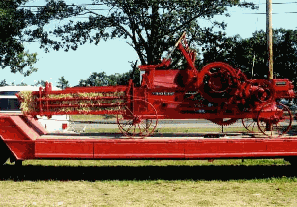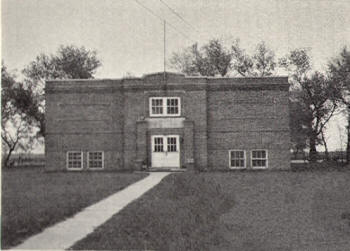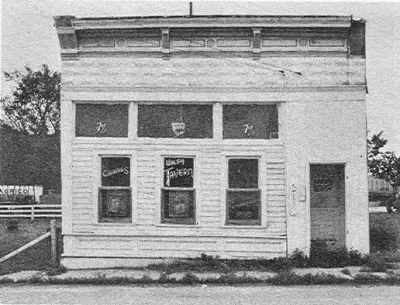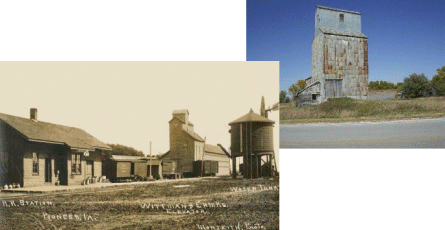|
Of all the towns and villages of Humboldt County, Pioneer has the most
unique beginning. Later, it was to have the unique distinction of
being the greatest grain center and having the largest elevators in
the county.
In 1881, the Hay Press Company purchased the property, which is now
the town of Pioneer. The reason for the purchase was not to farm, but
to cut the prairie grasses, bale them and then ship the bales to
cities in the East. Under the management of George B. Waller, the
business began in the fall of 1882. The hay camp at Pioneer was to be
the largest business of its kind in the Midwest states. The first
railroad line to service Pioneer was the Rock Island Railroad.

Example of a Hay Press
Before the actual cutting could start the company needed a press
building where large quantities of loose hay could be processed. This
building was constructed on the northwest corner of the intersection
east of Pioneer. The building measured 40 by 120 feet. Also, two
large barns were constructed to store the baled hay while they awaited
shipping. The storage barns were located near the railroad siding
for ease of loading. One barn was 50 by 100 feet and the second was
40 by 60 feet. The two barns had a combined capacity of 1,500 ton of
baled hay.
The vast acres of prairie grass were harvested during
the summer and then hauled to the press shed where it was pressed into
bales. Hay would be piled in big stack before it could be baled and a
wide circle was plowed around the area to protect the haystacks from
prairie fires. Horses were used for power on the baler because using
steam would have presented an extreme fire danger.
The crew of workers needed for the operation varied in size but
generally it was about forty men, who enjoyed constant employment. At
full capacity, the crew would process about 30 ton per day. The haying
crew lived and had their meals at the boarding house. There were also
three other dwellings in town, which I assume were also used to house
employees. Mr. and Mrs. Jeremiah Coleman were the first to cook and
care for the needs of the men.
The first Federal Census figures available for Pioneer are those
from 1910. The census shows that the population was 92 individuals. I
think it would be safe to assume that during the years of 1882 to 1900
that the population fell in the range of 50 to 80 people.
In 1882, J. M. Anderson opened a general store to accommodate the
needs of the hay camp crew. The same year, the Pioneer Hotel was
erected by J. J. Hartenbower. August and Minnie Zerbs purchased the
boarding house from Hartenbower in 1895, and it was reported, "They
ran a clean and orderly place of business." August Zerbs died on
September 25, 1913, at the age of 52. His wife remained proprietor
until her death July 27, 1939, at the age of 84. The city of Pioneer
purchased the building from the Zerbs estate in October 1940, for
$700. Since then it has been utilized as the town hall, election
polling and other functions.
In 1893, The Wisconsin Lumber Company opened for business. Some of
the managers were Ed Anderson, George Black, and the Heywood Brothers.
The community around Pioneer settled rather quickly, with people
from the east moving in to claim Homestead and Swampland Grants. The
first school that served the area was built in the early 1900's; on
the southwest corner of the intersection, one-half mile east and one
half mile north of Pioneer. With the larger number of children being
in the town, parents became disgruntled that their children had to
walk the mile to school. One night, after the close of school, the
gentlemen of the town moved the school into Pioneer, placing it on the
southeast corner of the intersection of Main and Gilmore Streets. The
children resumed school the next day.
On Aug 5, 1929, Frank Griffith of Fort Dodge was employed to
supervise the building of a new brick schoolhouse, on property owned
by the district. An architect, his fee was to be three percent of the
cost of construction. On Aug. 31 1929, the contract for construction
was awarded to J. H. Mayer of Fort Dodge, at the cost of $10,000.
Also, F. C. Mayor, of Barnum, Minnesota, was contracted to drill a well on the
school property, at a cost of $1.50 per foot. The well was not to
exceed 100 feet; water guaranteed, or no pay. In the fall of 1929, the
children attended classes in the two churches until completion of the
school. Classes were moved into the new building in December, of 1929.
The teachers at this time were Johanna (Lynch) Collins and Grace
Collins. The children simply picked up their books and walked across
the street. High school classes were offered from the early 1930's,
until 1946. On July 22, 1957, the school board ruled the close of
Pioneer school. The children were to attend the Gilmore City Community
School, as they still do today.

Pioneer School
In 1898, M. M. Haptanstall, believing Pioneer to be a successful
location for banking, opened the Farmers Saving Bank, with himself as
cashier. There were numerous stockholders in this bank, some were
prominent people of the town. Some of these men were Harry Fraser, T.
A. Greiner, James Murray, S. Narbo, C. F. Wittman, and J. F. Wittman.
This bank stood on lot 7 block 3, on the south side of Main Street,
and was a branch office of the Gilmore City Exchange Bank. All forms
of banking were offered here, serving not only the people of the town,
but also the farmers of the community. In the 1920's, D. R. Miles was
head cashier, and lived in a home on the north side of Park Street,
which was built by M. M. Haptanstall. This bank closed in June 1927.

Pioneer Farmers Saving Bank building
Later, Estella and Vitalis Walsh purchased the bank building, where
they operated Walsh's Tavern for many years. Jack Loftus was
bartender, and known by many. It closed in the middle 1960's. Later,
it was purchased by Wilbert Habben, and the building torn down.

Pioneer's Railroad Depot and
Elevator c. 1910 and what remained in 2003
Pioneer is known for being a grain center and has been for many
years past. The Rowe Grain Elevator was the first facility for grain
storage in the town. It sat on the north side of the street, across
from the now existing Coop office. It had a crib, shaped of solid
construction for shelled corn, and had a large, long corncrib that sat
north along the railroad tracks. In the early 1900's, ear corn was
bought by the elevators, as well as shelled corn. Later a brick silo
storage bin was also built. The Rock Island Railroad depot sat between
the main line and the siding, on the south side of Main Street.
By 1900, J. M. Anderson was postmaster, general store owner and was
engaged in the grain, livestock and coal shipping business. Joe had
been in partnership with C. F. Wittman earlier, but that partnership
was dissolved before 1899.
C. F. Wittman and his brother in law, A. H. Ehmke, formed a
partnership in 1899. Together they built a large two story building.
From this location they conducted an implement, coal and grain
business. This building sat on lot 4. As well as the store, a large
elevator and scale were also built. This elevator was larger then the
Rowe Elevator. Mr. Wittman was remembered as being a real gentleman
and a sharp businessman. Wittman & Ehmke sold all types of John Deere
farm equipment such as; threshers, engines, pumps, windmills, fancy
topped buggies, and etc.. They also did repair on what they sold. In
1916, Wittman purchased six Model T cars, which were shipped in on two
rail cars, three to a car. Four of the cars were sold for $295 each to
the following: Charlie Himrod, Andrew Stensland, Edward Dyvig, and Jim
Connelly. Charlie Wittman would loan the money to his customers to buy
his merchandise, but on a legal note basis. This also became a
business for him. On the second floor of the store, all kinds of fancy
horse buggies, and surreys were displayed. This building burned in
1921, and was rebuilt sometime around 1924.
In 1914, Clarence A. Rowe built a new elevator. It was located on
the west side of the main tract, on the north side of Main Street, and
named the Farmers Co-op Elevator. At the time, it was considered the
largest elevator in the area. Its total capacity was about 10,000
bushel. Later owners were Ben Abben, and O. T. Henrichs.
In 1927, Davis Brothers and Potter, built the main structure of the
now existing elevator, with a capacity of over 100,000 bushels of
grain. Early employees were Jack Collins, and Frank George. Guy B.
Graham was hired in 1930 to manage the office. In 1933-34, Vincent
Walsh was employed as an outside man, at the high wage of $1.50 per
hour. The partnership dissolved between Davis Brothers and Potter, and
Fred M. Davis became sole owner, with Guy remaining as manager. The
north and south annexes were completed in 1957, making the total
capacity of 236,700 bushels. This business was auctioned in 1965, and
purchased by the Gilmore City Co-op Company. In 1968, there was a
merger of this company with the Rolfe, and Bradgate Co-ops, forming
the company as it exists today. In 1976, a cement silo structure was
built, with capacity of 312,000 bushels. In 1982, two more cement
silos where built, with a capacity of 700,000 bushels.
Harry Dolder shared with me that his grandparents, Louis and Anna
Dolder moved to Pioneer February 23, 1903. Louis farmed until 1924.
The last two Dolder children, Iola Mae and Harold J., were born in
Pioneer. Louis became involved in many ventures other then farming. He
served for a period as the Town Marshall and Post Master. He also
managed the grain elevator in Pioneer, and later at Gilmore City.
Louis and his brother, George, operated a harness and shoe repair
business in Pioneer before moving to Humboldt in the 1930's.
Dale Himrod's father came to Iowa from Pennsylvania in 1892 and
settled in Pioneer. Dale recalled that around 1914 there were two
grain elevators, a drug store, two general stores, a bank, telephone
exchange, blacksmith shop, a lumberyard, implement store, harness
shop, hotel, post office, restaurant and the M. E. Church. In the
1940's the towns population peaked at 128 souls.
In 1960, the town received an over-payment in federal funds because
of an error in the Census. The funds could only be used for street
construction, repair and improvements. Pioneer used the funds to
improve their streets. It was probably the only town of its size, in
Iowa, to have mercury vapor street lighting, blacktopped streets and
alleys.
In 1978, there was one grain elevator, a welding and repair shop,
one general trucking firm, a tavern and the mail was delivered on a
country route. The town's population had fallen to 40 people.
Other Businesses
A stockyard buying station. Boyd Himrod, and Bill Walsh, were two
of its' managers.
Joe Anderson's General Store, which included the post office.
Later, it was the Webster and Henrichs General Store, and after it
burned down, it was later rebuilt by John F. Wittman.
The town had a jail and office for its police authorities. However,
the building was moved to the farm of Ardis and Bob Fevold to be used
for tool shop.
Some owners of Pioneer restaurants have been: a Mr. Hunt; Gertie
and Ottie McKinney; John St. Claire; and Charlotte and Albert Heun.
There was a meat and confectionary store, managed by Bill Dawson
and Albert Heun.
An automotive garage was built by Maurice Voote. He sold it to Hank
Henricks, with Roy Greenland as a mechanic. "Greasy" Johnson later
owned the garage.
Mrs. Vance Jeffers ran the telephone office for many years. Mrs.
Elmo Henrichs worked as a telephone operator.
The E. E. Webster General Store carried a complete stock of guns,
nails, clothing, and neck yokes, as well as groceries. Dave Pollock
owned a harness shop.
Thede Jennings owned and operated a livery barn.
A lot of history for a little town that is fading into Iowa
farmland. For the people that have called Pioneer their home town,
their memories will not fade.

Pioneer on the horizon
|